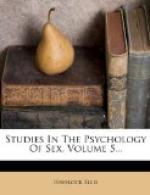[36] The Countess of Pembroke, Sir Philip Sidney’s sister, appears to have found sexual enjoyment in the contemplation of the sexual prowess of stallions. Aubrey writes that she “was very salacious and she had a contrivance that in the spring of the year ... the stallions ... were to be brought before such a part of the house where she had a vidette to look on them.” (Short Lives, 1898, vol. i, p. 311.) Although the modern editor’s modesty has caused the disappearance of several lines from this passage, the general sense is clear. In the same century Burchard, the faithful secretary of Pope Alexander VI, describes in his invaluable diary how four race horses were brought to two mares in a court of the Vatican, the horses clamorously fighting for the possession of the mares and eventually mounting them, while the Pope and his daughter Lucrezia looked on from a window “cum magno risu et delectatione.” (Diarium, ed Thuasne, vol. III, p. 169.)
[37] Archivio di Psichiatria, 1902, fasc. ii-iii, p. 338. In the case of pathological sexuality in a boy of 15, reported by A. MacDonald, and already summarized, the sight of copulating flies is also mentioned among many other causes of sexual excitation.
[38] Krafft-Ebing presents or quotes typical cases of all these fetiches, Op. cit., pp. 255-266.
[39] G. Stanley Hall, “A study of Fears,” American Journal of Psychology, 1897, pp. 213-215.
[40] Op. cit., p. 268.
[41] W. Howard, “Sexual Perversion,” Alienist and Neurologist, January, 1896. Krafft-Ebing (op. cit., p. 532) quotes from Boeteau the somewhat similar case of a gardener’s boy of 16—an illegitimate child of neuropathic heredity and markedly degenerate—who had a passion, of irresistible and impulsive character, for rabbits. He was declared irresponsible. Moll (Untersuchungen ueber die Libido Sexualis, bd. i, pp. 431-433) presents the case of a neurotic man who from the age of 15 had been sexually excited by the sight of animals or by contact with them. He had repeatedly had connection with cows and mares; he was also sexually excited by sheep, donkeys, and dogs, whether female or male; the normal sexual instinct was weak and he experienced very slight attraction to women.
[42] Moll also remarks ("Perverse Sexualempfindung,” in Senator’s and Kaminer’s Krankheiten und Ehe) that in this matter it is often hardly possible to draw a sharp line between vice and disease.
[43] Instances of this widespread belief—found among the Tamils of Ceylon as well as in Europe—are quoted from various authors by Bloch, Beitraege zur AEtiologie der Psychopathia Sexualis, Teil II, p. 278, and Moll, Untersuchungen ueber die Libido Sexualis, bd. i, p. 700. On the frequency of bestiality, from one cause or another, in the East, see, e.g., Stern, Medizin und Geschlechtsleben in der Tuerkei, bd. ii, p. 219.




